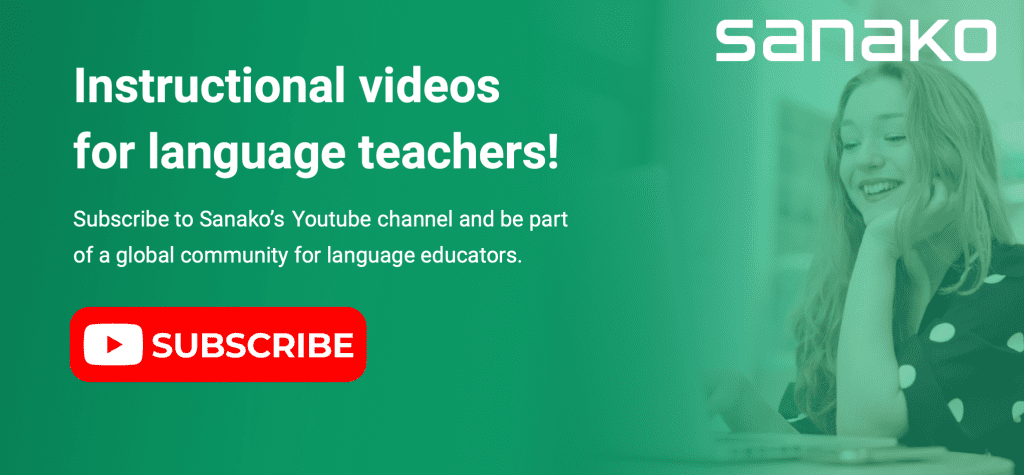Like much of education, the world of language teaching has its own very specific terminology and is packed full of strange acronyms. Sanako has therefore put together this detailed glossary of terms to help tell the difference between language teaching terms like ESL, EFL, TEFL and TESL and between CELTA and DELTA!
A
ACCENT
Refers to how a student pronounces words and phrases when speaking a language. Commonly reflects their native language, where they were born, and sometimes their socio-economic status.
ACCURACY
The ability to produce grammatically correct sentences in written or spoken form.
ADVANCED
The word advanced refers to levels C1 and C2 as defined in the Global Scale grid of the Common European Framework of Reference for Languages.
AUTHENTIC MATERIAL
Resources in the target language are used for language learning and teaching purposes. This may include podcasts, newspapers, films, travel timetables – the list is endless!
Authentic materials are often used in authentic tasks which see students using their target language in a real-world context (e.g writing a job application, asking for directions, etc).
AUDITORY LEARNERS
Students who learn best by listening to native speakers and/or by having conversations with other people.
B
BEGINNER
The word beginner refers to levels A1 and A2 as defined in the Global Scale grid of the Common European Framework of Reference for Languages.
BICS (BASIC INTERPERSONAL COMMUNICATION SKILLS)
BICS is often referred to as “playground English”, “survival English”, or “social language.” It is the basic language ability required for face-to-face communication where linguistic interactions are embedded in a situational context called context-embedded language.
BUSINESS ENGLISH
This form of the English language is used in business or industrial settings such as in the office, a negotiation, an interview, or a corporate document.
C
CALP (COGNITIVE ACADEMIC LANGUAGE PROFICIENCY)
This is the term that defines the language ability required for academic achievement in a context-reduced environment. Examples of context-reduced environments include classroom lectures and textbook reading assignments, where there are few environmental cues (facial expressions, gestures) that help students understand the content
CELTA (CERTIFICATE OF ENGLISH LANGUAGE TEACHING TO ADULTS)
CELTA is a qualification for teaching English as a foreign language. It focuses on developing practical skills with face-to-face teaching practice, which provides prospective teachers with the techniques and confidence they need to begin teaching as soon as they finish the course.
CLOZE TEST
This is an exercise, test, or assessment consisting of a portion of language with certain items, words, or signs removed, where the participant is asked to replace the missing language item.
D
DELTA
Delta is the Diploma in Teaching English to Speakers of Other Languages and it is an advanced TEFL qualification. It can only be taken by qualified English teachers with a few years of teaching experience, who are looking to advance their qualifications.
DIFFERENTIATION
This occurs when all students in a class are learning the same subject matter but at different levels of difficulty and potentially with different resources.
DIRECT METHOD
A commonly used technique in language teaching where students are only able to use the target language and cannot use their mother tongue at all.
DRILL
Frequent repetition of a grammatical construct or vocabulary in a highly-regimented fashion.
E
EAL (ENGLISH AS AN ADDITIONAL LANGUAGE)
An EAL student is one whose first language is something other than English.
EFL (ENGLISH AS A FOREIGN LANGUAGE)
This term is used when students want to learn and use English as an additional language in a country where English is not the primary language.
EL (ENGLISH LEARNER)
An EL is a student who uses another language in addition to or other than English.
ELD (ENGLISH LANGUAGE DEVELOPMENT)
Usually delivered in a classroom, ELD means teaching that has been specifically designed for English language learners to develop their listening, speaking, reading, and writing skills in English.
ELF (ENGLISH AS A LINGUA FRANCA)
Teaching English as a LINGUA FRANCA refers to a methodology that does not expect all English speakers to be native English speakers, but understands and takes into account the huge diversity of language and cultural backgrounds of different English speakers. The ELF method takes therefore a different approach than ESL and EFL in which the English language ideal is based on native US or UK Englishes.
ELT (ENGLISH LANGUAGE TEACHER/TRAINING)
This is a broad term that refers generically to all types of English language teaching.
ESL (ENGLISH AS A SECOND LANGUAGE)
An ESL learner is someone from a nation where English is not the native language who has moved, either temporarily or permanently, to study English in a country where English is the native language (e.g The United Kingdom or the United States).
ESOL (ENGLISH FOR SPEAKERS OF OTHER LANGUAGES)
ESOL refers to the use of English by speakers with different native languages and the teaching of non-native English speakers.
F
FLUENCY
The ability of a learner to easily express themselves in their target language without seeming to make an effort.
G
GAP-FILL
A common exercise in which the teacher removes some words from a piece of text which the students then have to complete. The missing words have been specifically chosen to test a particular concept or item of vocabulary.
GRAMMAR
The part of the language system concerned with the way a language is structured. It usually includes syntax and morphology (including inflections) and sometimes also phonology and semantics.
I
IELTS (INTERNATIONAL ENGLISH LANGUAGE TESTING SYSTEM)
IELTS is an international standardized test of English language proficiency for non-native English language speakers.
INTERMEDIATE
The word intermediate refers to levels B1 and B2 as identified in the Global Scale grid of the Common European Framework of Reference for Languages.
IPT (IDEA PROFICIENCY TEST)
The IDEA Oral Language Proficiency Test (IPT II), an individually administered measure of speaking and listening proficiency in English as a Second Language. It is designed for children and the test assesses their reading, written, and oral English abilities.
K
KINESTHETICS
Sometimes called a hands-on learner, a kinesthetic learner prefers to learn by doing, by moving, and by getting involved.
L
L1
First (primary or native) language
L2
Second language
LANGUAGE LABORATORY
A dedicated or repurposed room in an educational institution with a combination of computers and/or audio equipment for the purpose of language learning. For more information about language labs, see our blog post on the topic here.
LANGUAGE SKILLS
This phrase typically refers to the four main elements of a language course – listening, speaking, reading, writing.
LEVEL
Each student is different and will be at a different stage of the language learning journey. These are commonly referred to as levels, such as beginner, intermediate and advanced.
M
MULTISENSORY
Teaching activities or resources in which the learner has to use a variety of their senses at the same time. This will therefore include listening, seeing, and touching
MULTILINGUAL
Someone is proficient in more than two languages.
N
NATIVE LANGUAGE
The language that a person hears and learns in childhood. Often referred to as their mother tongue.
NATIVE SPEAKER
Someone whose native language is the learner’s target language.
P
PPP
Presentation, Practice, and Production – typically seen as the main components of a language lesson.
PRONUNCIATION
The part of a language system that is focused on how the target language is spoken, including features such as intonation and stress.
R
ROLE-PLAY
A form of speaking practice where students pretend to be different characters in order to make the conversation more realistic.
S
SOURCE LANGUAGE
This term refers to the language in which a particular learning material or resource is presented.
T
TARGET LANGUAGE
This is the language that the student wishes to learn or the language into which material is being translated.
TASK-BASED LEARNING
This language teaching strategy recognises that language is a tool that we use to communicate in order to get things done. So TBLT focuses students on solving tasks that involve the realistic use of target language, rather than simply concentrating on grammatical and linguistic concepts or communicative functions. For more information, see our blog post on the topic here.
TEAL (TEACHING ENGLISH AS AN ADDITIONAL LANGUAGE)
A graduate qualification that is widely offered by universities globally. It allows the language educator to work at the university level.
TESOL (TEACHERS OF ENGLISH TO SPEAKERS OF OTHER LANGUAGES)
Teachers gain a TESOL certification with the intention to teach English to EFL learners i.e to non-native speakers in a country where English is or is not the primary language.
The term also refers to the TESOL International Association, the largest international, professional organization for teachers of English as a second or foreign language.
TESL (TEACHING ENGLISH AS A SECOND LANGUAGE)
Teachers with a TESL certification typically plan to teach English to non-native speakers in a country where English is the primary language, such as Australia or Canada.
TEFL (TEACHING ENGLISH AS A FOREIGN LANGUAGE)
A broad term that pertains to the teaching of English to people whose first language is not English, especially people from a country where English is not spoken.
TOEFL (TEST OF ENGLISH AS A FOREIGN LANGUAGE)
This is a standardized test that measures the English language ability of non-native speakers wishing to enroll in English-speaking universities. The test is accepted by more than 11,000 universities and other institutions in over 150 countries.
TOEIC (TEST OF ENGLISH FOR INTERNATIONAL COMMUNICATION)
TOEIC is an international standardized test of English language proficiency for non-native speakers. It is intentionally designed to measure the everyday English skills of people working in an international environment.
TTT/TTR
Teacher Talking Time / Teacher Talking Ratio.
S
STT/STR
Student Talking Time / Student Talking Ratio.
U
USE / USAGE
Use is how the target language is actually used in real-life communication. This is different from usage, which refers to the rules for making language, i.e. the structures used.
V
VIRTUAL CLASSROOM
An online environment that allows teachers and learners to see, hear and interact with each other in real-time. Participants can also share and view teaching resources, conduct tests or exercises, and through which teachers can provide feedback and results. Sanako Connect is a great example of a virtual classroom.
VOCABULARY
This word has two key meanings for language learning/teaching. It relates to both the language system that is concerned with knowledge of words and the words known and understood by a particular student.
W
WHOLE-LANGUAGE ACTIVITIES
Activities that encourage students to use all aspects of language – speaking, listening, writing, and reading.
If you’re a language teacher who’s looking for inspiration to design and explore new language learning paths, then do check out Sanako’s Youtube channel and become a part of our global community for language educators. Subscribe now to receive the latest instructional videos for language teachers!

